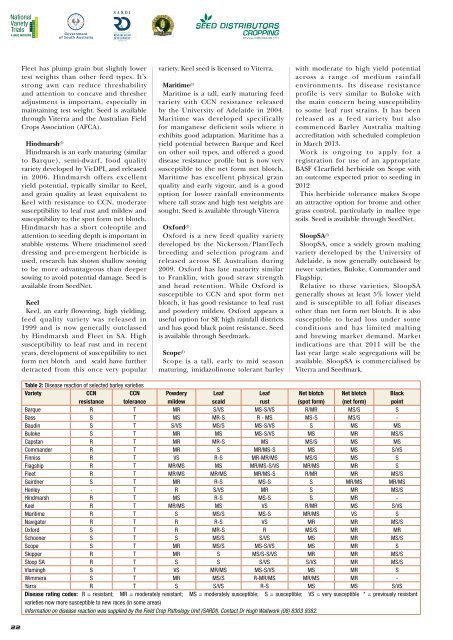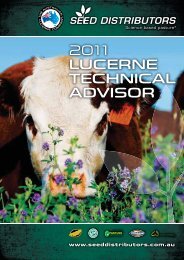Lentil variety sowing guide 2012 - Seed Distributors
Lentil variety sowing guide 2012 - Seed Distributors
Lentil variety sowing guide 2012 - Seed Distributors
You also want an ePaper? Increase the reach of your titles
YUMPU automatically turns print PDFs into web optimized ePapers that Google loves.
22<br />
Fleet has plump grain but slightly lower<br />
test weights than other feed types. It’s<br />
strong awn can reduce threshability<br />
and attention to concave and thresher<br />
adjustment is important, especially in<br />
maintaining test weight. <strong>Seed</strong> is available<br />
through Viterra and the Australian Field<br />
Crops Association (AFCA).<br />
Hindmarsh A<br />
Hindmarsh is an early maturing (similar<br />
to Barque), semi-dwarf, food quality<br />
<strong>variety</strong> developed by VicDPI, and released<br />
in 2006. Hindmarsh offers excellent<br />
yield potential, typically similar to Keel,<br />
and grain quality at least equivalent to<br />
Keel with resistance to CCN, moderate<br />
susceptibility to leaf rust and mildew and<br />
susceptibility to the spot form net blotch.<br />
Hindmarsh has a short coleoptile and<br />
attention to seeding depth is important in<br />
stubble systems. Where triadimenol seed<br />
dressing and pre-emergent herbicide is<br />
used, research has shown shallow <strong>sowing</strong><br />
to be more advantageous than deeper<br />
<strong>sowing</strong> to avoid potential damage. <strong>Seed</strong> is<br />
available from <strong>Seed</strong>Net.<br />
Keel<br />
Keel, an early flowering, high yielding,<br />
feed quality <strong>variety</strong> was released in<br />
1999 and is now generally outclassed<br />
by Hindmarsh and Fleet in SA. High<br />
susceptibility to leaf rust and in recent<br />
years, development of susceptibility to net<br />
form net blotch and scald have further<br />
detracted from this once very popular<br />
<strong>variety</strong>. Keel seed is licensed to Viterra.<br />
Maritime A<br />
Maritime is a tall, early maturing feed<br />
<strong>variety</strong> with CCN resistance released<br />
by the University of Adelaide in 2004.<br />
Maritime was developed specifically<br />
for manganese deficient soils where it<br />
exhibits good adaptation. Maritime has a<br />
yield potential between Barque and Keel<br />
on other soil types, and offered a good<br />
disease resistance profile but is now very<br />
susceptible to the net form net blotch.<br />
Maritime has excellent physical grain<br />
quality and early vigour, and is a good<br />
option for lower rainfall environments<br />
where tall straw and high test weights are<br />
sought. <strong>Seed</strong> is available through Viterra<br />
Oxford A<br />
Oxford is a new feed quality <strong>variety</strong><br />
developed by the Nickerson/PlantTech<br />
breeding and selection program and<br />
released across SE Australian during<br />
2009. Oxford has late maturity similar<br />
to Franklin, with good straw strength<br />
and head retention. While Oxford is<br />
susceptible to CCN and spot form net<br />
blotch, it has good resistance to leaf rust<br />
and powdery mildew. Oxford appears a<br />
useful option for SE high rainfall districts<br />
and has good black point resistance. <strong>Seed</strong><br />
is available through <strong>Seed</strong>mark.<br />
Scope A<br />
Scope is a tall, early to mid season<br />
maturing, imidazolinone tolerant barley<br />
with moderate to high yield potential<br />
across a range of medium rainfall<br />
environments. Its disease resistance<br />
profile is very similar to Buloke with<br />
the main concern being susceptibility<br />
to some leaf rust strains. It has been<br />
released as a feed <strong>variety</strong> but also<br />
commenced Barley Australia malting<br />
accreditation with scheduled completion<br />
in March 2013.<br />
Work is ongoing to apply for a<br />
registration for use of an appropriate<br />
BASF Clearfield herbicide on Scope with<br />
an outcome expected prior to seeding in<br />
<strong>2012</strong><br />
This herbicide tolerance makes Scope<br />
an attractive option for brome and other<br />
grass control, particularly in mallee type<br />
soils. <strong>Seed</strong> is available through <strong>Seed</strong>Net.<br />
SloopSA A<br />
SloopSA, once a widely grown malting<br />
<strong>variety</strong> developed by the University of<br />
Adelaide, is now generally outclassed by<br />
newer varieties, Buloke, Commander and<br />
Flagship.<br />
Relative to these varieties, SloopSA<br />
generally shows at least 5% lower yield<br />
and is susceptible to all foliar diseases<br />
other than net form net blotch. It is also<br />
susceptible to head loss under some<br />
conditions and has limited malting<br />
and brewing market demand. Market<br />
indications are that 2011 will be the<br />
last year large scale segregations will be<br />
available. SloopSA is commercialised by<br />
Viterra and <strong>Seed</strong>mark.<br />
Table 2: Disease reaction of selected barley varieties<br />
Variety CCN<br />
CCN Powdery Leaf<br />
Leaf Net blotch Net blotch Black<br />
resistance tolerance mildew scald<br />
rust (spot form) (net form) point<br />
Barque R T MR S/VS MS-S/VS R/MR MS/S S<br />
Bass S T MS MR-S R - MS MS-S MS/S -<br />
Baudin S T S/VS MS/S MS-S/VS S MS MS<br />
Buloke S T MR MS MS-S/VS MS MR MS/S<br />
Capstan R T MR MR-S MS MS/S MS MS<br />
Commander R T MR S MR/MS-S MS MS S/VS<br />
Finniss R T VS R-S MR-MR/MS MS/S MS S<br />
Flagship R T MR/MS MS MR/MS-S/VS MR/MS MR S<br />
Fleet R T MR/MS MR/MS MR/MS-S R/MR MR MS/S<br />
Gairdner S T MR R-S MS-S S MR/MS MR/MS<br />
Henley - T R S/VS MR S MR MS/S<br />
Hindmarsh R T MS R-S MS-S S MR -<br />
Keel R T MR/MS MS VS R/MR MS S/VS<br />
Maritime R T S MS/S MS-S MR/MS VS S<br />
Navigator R T R R-S VS MR MR MS/S<br />
Oxford S T R MR-S R MS/S MR MR<br />
Schooner S T S MS/S S/VS MS MR MS/S<br />
Scope S T MR MS/S MS-S/VS MS MR S<br />
Skipper R T MR S MS/S-S/VS MR MR MS/S<br />
Sloop SA R T S S S/VS S/VS MR MS/S<br />
Vlamingh S T VS MR/MS MS-S/VS MS MR S<br />
Wimmera S T MR MS/S R-MR/MS MR/MS MR -<br />
Yarra R T S S/VS R-S MS MS S/VS<br />
Disease rating codes: R = resistant; MR = moderately resistant; MS = moderately susceptible; S = susceptible; VS = very susceptible * = previously resistant<br />
varieties now more susceptible to new races (in some areas)<br />
Information on disease reaction was supplied by the Field Crop Pathology Unit (SARDI). Contact Dr Hugh Wallwork (08) 8303 9382.




